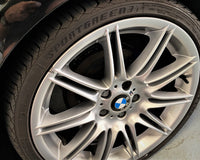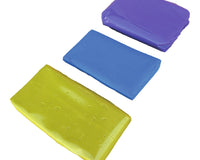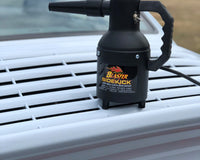Ceramic coatings have revolutionised car care, offering long-lasting protection and a high-gloss finish that keeps vehicles looking new for longer. While these coatings provide an impressive shield against environmental contaminants and minor scratches, they still require proper maintenance to perform at their best. Neglecting the care of your ceramic coating can diminish its longevity and shine, leaving your car vulnerable to the elements. This guide will cover essential long-term care tips to help you maintain the maximum shine and protection of your ceramic coating.
Understanding Ceramic Coatings: The Basics
Before diving into maintenance tips, it’s essential to understand what ceramic coatings are and why they need proper care. Ceramic coatings are liquid polymers applied to a vehicle’s exterior, bonding chemically with the factory paint to create a protective layer. Unlike waxes or sealants, ceramic coatings are more durable, providing a harder and longer-lasting layer of protection against UV rays, chemical stains, and road grime.
However, while ceramic coatings are highly resistant to contaminants, they are not invincible. Contaminants such as bird droppings, tree sap, and industrial fallout can still damage the coating if not removed promptly. Regular maintenance is crucial to preserving the coating's hydrophobic properties and keeping the surface looking glossy and smooth.
Washing Your Ceramic-Coated Car: The Right Techniques
The Importance of Safe Washing Practices
The most critical aspect of maintaining a ceramic coating is adopting a safe washing routine. Improper washing techniques can cause swirl marks and reduce the effectiveness of the coating. Always opt for a two-bucket method when washing your car—one bucket for the soapy water and another for rinsing your mitt. This reduces the chances of dragging dirt and contaminants across the surface, which can cause scratches.
Use a pH-neutral car shampoo specifically designed for ceramic-coated cars. These shampoos are gentle on the coating, ensuring that the hydrophobic layer remains intact. Avoid using dish soap or other harsh detergents, as they can strip away the coating and degrade its protective properties.
Drying Without Damage
Once your car is washed, drying it properly is just as important. Using a microfiber drying towel is highly recommended to avoid scratching the surface. Microfiber towels are soft and highly absorbent, making them ideal for safely drying a ceramic-coated car. Avoid using air blowers that may blow dirt particles onto the paint, potentially causing damage.
Be mindful not to let water sit on the surface for too long, as water spots can form even on ceramic coatings. These spots are caused by the minerals in tap water, and if left unchecked, they can etch into the coating over time. A quick drying process will prevent water spots and keep your car's finish pristine.
Decontamination: Removing Embedded Contaminants
The Role of Iron Removers
Even with regular washing, some contaminants can become embedded in the ceramic coating. Iron fallout from brake dust and industrial particles can bond with the surface, dulling the shine and reducing the coating's effectiveness. Using an iron remover is a key step in maintaining the cleanliness of your coating. These specialised products chemically dissolve iron particles, making it easy to rinse them away without scrubbing.
To apply an iron remover, spray it onto the surface of the car after washing but before drying. Allow the product to sit for a few minutes, where it will begin to react with the iron particles and turn purple. Rinse the car thoroughly with water to remove the dissolved particles. This process will help maintain the smoothness and gloss of the ceramic coating.
Using a Clay Bar or Clay Mitt
For more stubborn contaminants that are not removed by iron removers, a clay bar or clay mitt can be used to decontaminate the surface. These tools work by gently shearing off bonded contaminants, such as tar, tree sap, and overspray, from the coating. However, using a clay bar too frequently can wear down the ceramic coating, so it should only be done when necessary.
To use a clay bar or clay mitt, apply a clay lubricant to the surface and gently rub the clay over the affected areas in a back-and-forth motion. The lubricant will help prevent scratching as the clay picks up embedded contaminants. Once the surface feels smooth, rinse the car and proceed with a gentle wash to remove any remaining residue.
Boosting Protection: Ceramic Coating Maintenance Sprays
Enhancing Hydrophobic Properties
Ceramic coating maintenance sprays are designed to replenish the coating’s hydrophobic properties and boost its protection between full reapplications. These sprays contain silica or other ingredients that bond with the existing coating, enhancing its water-repellent abilities and restoring its slickness. They are easy to apply and can be used after each wash to keep the coating performing at its best.
To use a ceramic coating maintenance spray, apply it to a clean, dry surface and spread it evenly with a microfiber cloth. Buff off any excess with a second cloth, leaving behind a glossy, protected finish. Regular use of these sprays will help extend the life of your ceramic coating and keep your car looking freshly detailed.
Sealants vs. Maintenance Sprays
While ceramic maintenance sprays are excellent for topping up protection, some enthusiasts opt to use sealants for even longer-lasting results. Sealants provide a layer of synthetic protection that can last for several months, offering additional resistance against contaminants. However, sealants are not a replacement for ceramic coating; they work in tandem to offer an extra layer of defense.
Sealants are applied similarly to ceramic maintenance sprays but tend to be more durable. Depending on your environment and the demands placed on your car, you may choose to use a sealant for added peace of mind.
Protecting Against the Elements: Seasonal Considerations
Summer Care: Combatting Heat and UV Exposure
During the summer months, the intense heat and UV rays can take a toll on your car’s ceramic coating. While the coating provides a strong defense against the sun, prolonged exposure can still lead to fading and reduced gloss. Parking your car in a shaded area or using a car cover can prevent the sun from beating down on the surface for extended periods.
Additionally, frequent washing is crucial during the summer, as contaminants such as bird droppings and bug splatter can bake onto the coating under the hot sun. Prompt removal of these contaminants will prevent them from etching into the coating and damaging the paint underneath.
Winter Care: Protecting Against Salt and Grime
In the winter, ceramic-coated cars face different challenges, such as road salt and grime that can corrode the coating if not properly maintained. After driving in snowy or icy conditions, it’s essential to thoroughly wash your car to remove any salt or de-icing chemicals that have accumulated on the surface. A touchless wash or pressure wash is ideal for removing these contaminants without physically touching the paint, reducing the risk of scratches.
Applying a ceramic maintenance spray or sealant before winter sets in can provide an extra layer of protection against the harsh elements. These products will help repel water, snow, and road salt, making it easier to keep your car clean throughout the season.
Avoiding Common Mistakes: What Not to Do
Using Harsh Chemicals
One of the most common mistakes car owners make is using harsh chemicals on their ceramic-coated vehicles. Products like acidic wheel cleaners, degreasers, and household detergents can strip away the coating, leaving your car vulnerable to damage. Always choose pH-balanced, ceramic-friendly products when washing or detailing your car.
Skipping Regular Maintenance
Another mistake is assuming that a ceramic coating is a “set it and forget it” solution. While ceramic coatings are highly durable, they still require regular maintenance to stay effective. Skipping washes, neglecting decontamination, or failing to apply maintenance sprays will reduce the coating’s longevity and shine. Consistent care is key to maximising the benefits of your ceramic coating.

Conclusion: Long-Term Care for Maximum Shine
Maintaining a ceramic-coated car doesn’t have to be complicated, but it does require regular attention and the right products. By following proper washing techniques, decontaminating the surface as needed, and using maintenance sprays or sealants, you can keep your ceramic coating performing at its best. Remember to consider seasonal challenges and avoid common mistakes, and your car will continue to shine with that showroom finish for years to come. Investing a little time and effort into maintaining your ceramic coating will pay off in the form of long-lasting protection and a stunning, glossy appearance.




